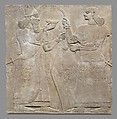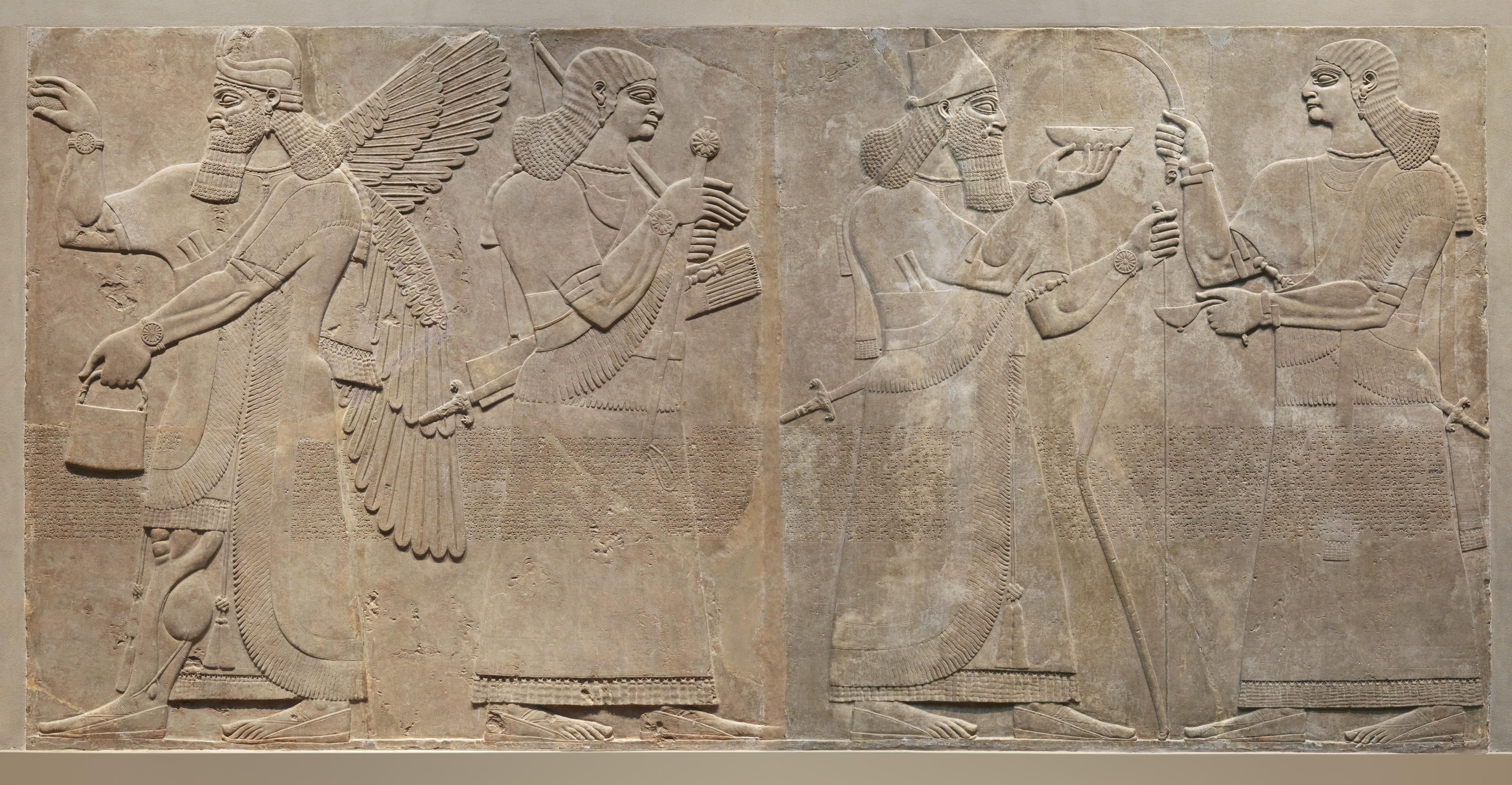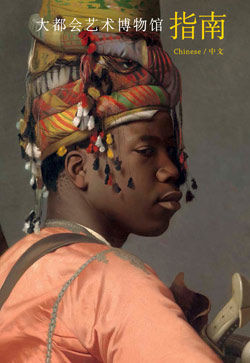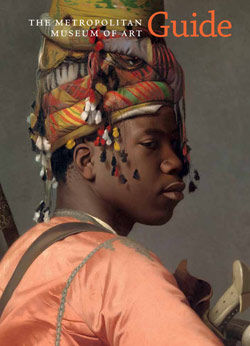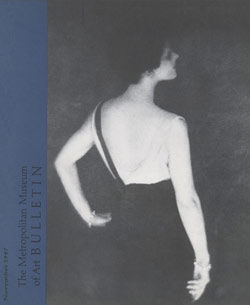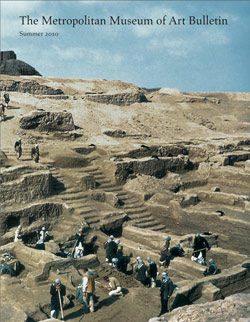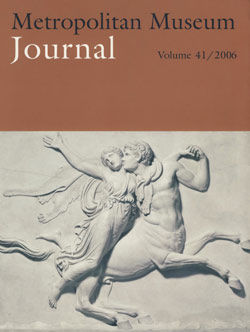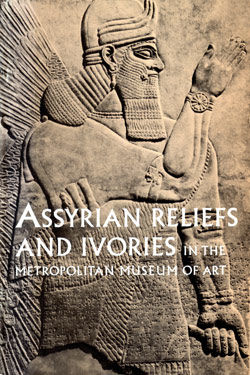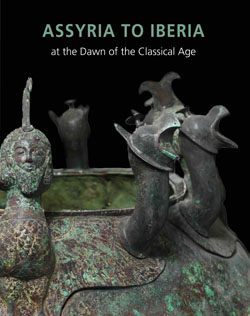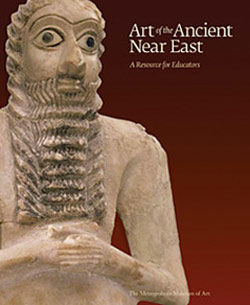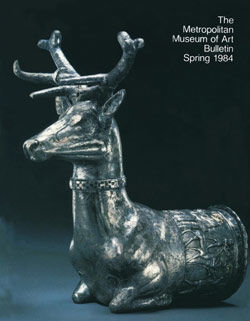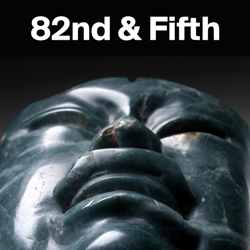Relief panel
Not on view
This relief, from the palace of the Assyrian king Ashurnasirpal II (r. ca. 883-859 B.C.), depicts a king, probably Ashurnasirpal himself, and an attendant. The two larger-than-life-sized figures are carved in low relief, and as with other reliefs in the palace featuring the image of the king, the carving is particularly fine and shows special attention to detail. The panel joins a second relief (32.143.6, see ‘Additional Images’ above) that shows a further attendant, also facing the king, and a winged supernatural protective figure. Together, the two panels show the king flanked by his human courtiers, just as in other scenes he or the Assyrian Sacred Tree are flanked by human and eagle-headed winged guardian figures.
The king is immediately identifiable by his crown, a distinctive truncated cone with a smaller cone emerging from the center, with a long ‘streamer’ hanging from its back. He is also recognizable by his luxuriant beard, and in the relief’s original state would have been further distinguished by his clothing, more elaborately embroidered than that of any other figure. The pigment that originally colored these reliefs is now lost, but the embroidery is still faintly visible in the form of fine inscised lines made by the sculptors over most areas of the king’s clothing. The king wears elaborate jewelry, including rosette bracelets, thick armlets worn above the elbow, large pendant earrings, and a necklace whose beads and spacers would probably have consisted of semiprecious stones and gold. The king carries a sword on his left hip, as well as two daggers tucked into his clothing, and in his left hand holds the tip of a bow. In his right hand, balanced on his fingertips, is a shallow bowl. In other reliefs the bowl contains wine and is used for pouring libations, for example on the bodies of slain animals following a royal hunt. Here, however, there is no apparent object for the libation. The relief comes from an area of the palace that seems to have held sarcophagi and might have been devoted to the cult of royal ancestors, and one possibility is that the libation is here being poured for the dead. For similar reasons, while it is normally thought that all such images of the king represent Ashurnasirpal, it has also been suggested that some may represent ancestral kings.
The second figure on the relief is beardless, and probably represents a eunuch. He is richly dressed, with jewelry including rosette bracelets, armbands, a collar of beads, probably of semiprecious stone with gold spacers, pendant earrings, and a crescent-shaped pectoral. At the ends of his short sleeves are bands of incised plant motifs representing embroidery; another incised band below the waist shows further plants but also birds, possibly ostriches. He carries a sword whose scabbard, like the king's, ends in the image of two roaring lions. At the sword's hilt another lion head can be seen; an object in the Metropolitan Museum's collection may be just such a hilt (54.117.20). In his right hand the eunuch holds a fly-whisk whose handle is carved in the shape of a ram's head. The object in his left hand may be an oil lamp, though it has also been suggested that it might be a ladle to replenish the wine in the bowl held by the king. Its handle terminates in the head of a snake, or more likely a fantastic composite creature, called Mushhushshu, associated with the god Ashur.
A distinctive feature of the Northwest Palace is the so-called Standard Inscription that ran across the middle of every relief, often cutting across the imagery. The inscription, carved in cuneiform script and written in the Assyrian dialect of the Akkadian language, lists the achievements of Ashurnasirpal II (r. 883–859 B.C.), the builder of the palace. After giving his ancestry and royal titles, the Standard Inscription describes Ashurnasirpal’s successful military campaigns to east and west and his building works at Nimrud, most importantly the construction of the palace itself. The inscription is thought to have had a magical function, contributing to the divine protection of the king and the palace.
#128. The Director's Tour, Second Floor: Reliefs from the Palace of Ashurnasirpal II, Part 1
-
128. The Director's Tour, Second Floor: Reliefs from the Palace of Ashurnasirpal II, Part 1
-
5875. The Director's Tour, Second Floor: Reliefs from the Palace of Ashurnasirpal II, Part 2
Playlist
Due to rights restrictions, this image cannot be enlarged, viewed at full screen, or downloaded.
This artwork is meant to be viewed from right to left. Scroll left to view more.
